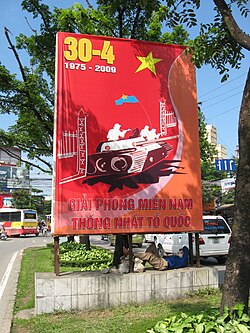Reunification Day
 From Wikipedia - Reading time: 6 min
From Wikipedia - Reading time: 6 min
| Reunification Day | |
|---|---|
 Banner in Hanoi for Reunification Day, 30 April 2013 | |
| Official name | Day of liberating the South for national reunification (Giải phóng miền Nam, thống nhất đất nước) |
| Also called | Reunification Day (Ngày Thống nhất) Liberation Day (Ngày Giải phóng) Victory Day (Ngày Chiến thắng)[1] |
| Observed by | Vietnamese |
| Type | National |
| Celebrations | Parades |
| Date | 30 April |
| Next time | 30 April 2026 |
| Frequency | Annual |
Reunification Day (Vietnamese: Ngày Thống nhất), also known as Victory Day (Ngày Chiến thắng), Liberation Day (Ngày Giải phóng or Ngày Giải phóng miền Nam), or by its official name, Day of the Liberation of the South and National Reunification (Ngày giải phóng miền Nam, thống nhất đất nước)[2] is a public holiday in Vietnam that marks the day when the People's Army of Vietnam and Liberation Army of South Vietnam captured Saigon (now Ho Chi Minh City), the capital of South Vietnam, on 30 April 1975, thus ending the Vietnam War.
The event marked the start of the transition period of reunification, which also occurred after a vote in the National Assembly for reunification on 2 July 1976,[3] when South Vietnam and North Vietnam were merged, forming the modern-day Vietnam.[4] The day was celebrated with a large military parade in Ho Chi Minh City in 2025, marking its 50th anniversary,[5] attended by several officials and army from countries friendly to Vietnam, including China, Cambodia, and Laos.[6][7]
Gallery
[edit]-
Statue commemorating the "Victory of 30 April 1975" at the Museum of the Ho Chi Minh Campaign
-
A street in Da Nang, Vietnam. Flags are displayed on the occasion of Reunification Day, a national holiday.
-
A sign in Hanoi, 2009, depicting the moment the Tank 390 crashed through the gate into the Presidential Palace on 30 April 1975.
-
A large road sign in Ho Chi Minh City, Vietnam, commemorating the 30 April 1975. The image bears the declaration of total victory.
See also
[edit]- 1954 division of Vietnam
- Liberation Day in other countries
- Unity Day in other countries
- Victory Day in other countries
- April 30 Park
References
[edit]- ^ "Bộ Luật lao động 2012". Thuvienphapluat.vn. Retrieved 30 April 2018.
- ^ Quân, Tin Liên (1 May 2016). "Nhiều hoạt động kỷ niệm 41 năm ngày Giải phóng miền Nam, thống nhất đất nước (30/4/1975 – 30/4/2016)" [Many activities to celebrate the 41st anniversary of the Liberation of the South and National Reunification (April 30, 1975 - April 30, 2016)]. Hànộimới (in Vietnamese). Retrieved 30 April 2018.
- ^ "Quốc hội quyết nghị lấy tên nước là Cộng hòa Xã hội chủ nghĩa Việt Nam" [The National Assembly resolved to name the country the Socialist Republic of Vietnam.]. People's Army Newspaper (in Vietnamese). Retrieved 17 August 2023.
- ^ "5. Cuộc tổng tuyển cử ngày 25 tháng 4 năm 1976 đánh dấu bước thắng lợi quyết định của nhân dân ta trên con đường thống nhất nước nhà về mặt nhà nước (Ngày 24 tháng 6 năm 1976)" [5. The general election on April 25, 1976 marked the decisive victory of our people on the path to national unification (June 24, 1976)] (in Vietnamese). Dangcongsan.vn. Retrieved 30 April 2018.
- ^ Nguyen, Minh; Guarascio, Francesco (30 April 2025). "'Victory of faith', Vietnamese celebrate 50 years since end of Vietnam War". Reuters. Retrieved 30 April 2025.
- ^ Pham, Nga (29 April 2025). "Despite improving relations, U.S. will be absent from Vietnam's war anniversary parade". NPR. Retrieved 30 April 2025.
- ^ "Celebrations in Ho Chi Minh City mark 50 years since end of Vietnam war". The Guardian. 30 April 2025. ISSN 0261-3077. Retrieved 30 April 2025.
 KSF
KSF


